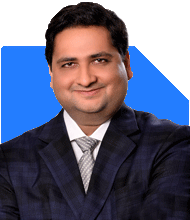Hardik Parikh | Answer |Ask -Follow
Tax, Mutual Fund Expert - Answered on Apr 19, 2023
He also holds an MBA degree from IIM-Indore.
Hardik, who began his career as an equity research analyst, founded his own advisory firm, Hardik Parikh Associates LLP, which provides a variety of financial services to clients.
He is committed to sharing his knowledge and helping others learn more about finance. He also speaks about valuation at different forums, such as study groups of the Western India Regional Council of Chartered Accountants.... more

Hello Sir, Myself Krishna. I am 45 years salaried. I am investing in MF from last 5 years. Currently the MF amount has grown to 20 Lakhs. I am investing around 15K in MF per month. I have invested around 5 Lakh in Indian stocks. I have an FD amount of 30 Lakhs. Apart from this I have invested around 60 Lakh in gold. I have Epf and PPF amount of about 25 Lakhs. I have invested in real estate ( 4 houses, 2 flats and 4 plots) in Bangalore. I want around 5 crores for my child education and for retirement. With my current investment, will I will be able to achieve my goal of 5 crores in the next 10-12 years.
It's great to see that you've been actively investing and diversifying your investments across various asset classes. You have done a good job of creating a robust investment portfolio. Let's take a look at your current investment and assess whether you can achieve your goal of 5 crores in the next 10-12 years.
As of now, you have:
Mutual Funds (MF) - ₹20 lakhs
Indian Stocks - ₹5 lakhs
Fixed Deposits (FD) - ₹30 lakhs
Gold - ₹60 lakhs
EPF & PPF - ₹25 lakhs
Real estate investments (4 houses, 2 flats, and 4 plots)
In addition to this, you are investing ₹15,000 per month in MFs.
To estimate whether your current investments will help you reach your goal of ₹5 crores in the next 10-12 years, we need to consider factors like inflation, average returns, and your risk appetite.
Assuming you're investing in a well-diversified MF portfolio, it's reasonable to expect an annualized return of around 12% on your MF investments. Considering the same rate of return, your monthly investment of ₹15,000 could grow to approximately ₹33 lakhs in the next 10 years.
Based on historical returns, we can assume an annualized return of around 7% for your FDs, 12% for your stocks, and 8% for your gold investments. Your EPF and PPF investments might provide an average return of around 8%. However, real estate returns are harder to predict as they vary significantly depending on the location and market conditions.
Assuming average returns, your current investment could grow to approximately ₹3.5 crores in the next 10 years, excluding real estate. Including real estate returns is difficult due to the unpredictable nature of the market, but it could potentially help you reach closer to your ₹5 crores goal.
It is important to review and adjust your investment strategy periodically to ensure that you're on track to achieve your financial goals. You may want to consider increasing your monthly MF investments or reallocating your portfolio to achieve better returns. It's always a good idea to consult a professional financial advisor to discuss your financial plan and strategies tailored to your specific needs.
I hope this helps, and I wish you all the best in your financial journey!
You may like to see similar questions and answers below
Ramalingam Kalirajan |10872 Answers |Ask -Follow
Mutual Funds, Financial Planning Expert - Answered on May 07, 2024
Ramalingam Kalirajan |10872 Answers |Ask -Follow
Mutual Funds, Financial Planning Expert - Answered on Jun 02, 2025
Ramalingam Kalirajan |10872 Answers |Ask -Follow
Mutual Funds, Financial Planning Expert - Answered on Jul 10, 2025
Purshotam Lal | Answer |Ask -Follow
Financial Planner, MF and Insurance Expert - Answered on Sep 24, 2025
Ramalingam Kalirajan |10872 Answers |Ask -Follow
Mutual Funds, Financial Planning Expert - Answered on Aug 04, 2025
Radheshyam Zanwar |6735 Answers |Ask -Follow
MHT-CET, IIT-JEE, NEET-UG Expert - Answered on Dec 06, 2025
Dr Nagarajan J S K |2576 Answers |Ask -Follow
NEET, Medical, Pharmacy Careers - Answered on Dec 06, 2025
Mihir Tanna |1090 Answers |Ask -Follow
Tax Expert - Answered on Dec 06, 2025
Ramalingam Kalirajan |10872 Answers |Ask -Follow
Mutual Funds, Financial Planning Expert - Answered on Dec 06, 2025
Radheshyam Zanwar |6735 Answers |Ask -Follow
MHT-CET, IIT-JEE, NEET-UG Expert - Answered on Dec 06, 2025
Radheshyam Zanwar |6735 Answers |Ask -Follow
MHT-CET, IIT-JEE, NEET-UG Expert - Answered on Dec 06, 2025
Radheshyam Zanwar |6735 Answers |Ask -Follow
MHT-CET, IIT-JEE, NEET-UG Expert - Answered on Dec 06, 2025
Dr Dipankar Dutta |1837 Answers |Ask -Follow
Tech Careers and Skill Development Expert - Answered on Dec 05, 2025
Dr Shyam Jamalabad |108 Answers |Ask -Follow
Dentist - Answered on Dec 05, 2025
Dr Shyam Jamalabad |108 Answers |Ask -Follow
Dentist - Answered on Dec 05, 2025




























